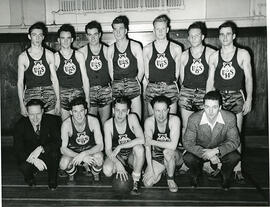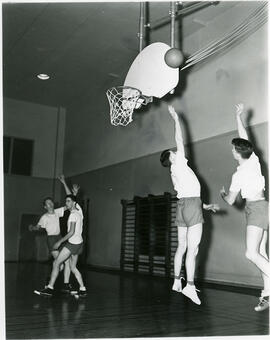Head and shoulders image of Dr. Larry Smith, head, Departments of Microbiology and Pathology, Ontario Veterinary College, Guelph, Ontario.
Bio/Historical Note: Dr. David Lawrence Thomson (Larry) Smith was born on 18 April 1914 in Regina, Saskatchewan. At age 25 in 1939, he had sufficient savings to enroll in veterinary medicine at the Ontario Veterinary College. With the outbreak of war, he sought to enlist, but the tuberculous scar on his lung made him unacceptable to the military. He then proceeded with his veterinary education at the Ontario Veterinary College (OVC) and graduated near the top of his class in 1943. For part of the next year he remained at OVC, serving as a junior faculty member working on poultry diseases. By 1943 the Canadian military had come to the realization that tuberculosis scars were not medical grounds for rejecting recruits. As a consequence Dr. Smith was called up as a private in the infantry. Once the army became aware of his professional training, he was commissioned as a lieutenant in the Royal Canadian Army Medical Corps and assigned to the research laboratory of the Directorate of Chemical Warfare and Smoke at Queen's University in Kingston, Ontario. In this capacity he served out the war and acquired valuable experience in microbiology and research. Dr. Smith also had the opportunity for private practice with a local practitioner during off hours and was able to apply some of his clinical veterinary education. He returned as a faculty member to the OVC, in the Department of Pathology in 1946. Dr. Smith returned to full time employment at the OVC in 1948, where he taught in the Department of Pathology. He was on staff at New York State Veterinary College from 1949-1952. He served as a faculty member at the OVC from 1952-1963. In 1962 Dr. Smith spent four months touring veterinary institutions in Europe and Great Britain; this experience was invaluable when it came time to plan the new veterinary college in Saskatoon. In the fall of 1963 the four western provinces and the federal government agreed to proceed with the development of a new veterinary college in western Canada. The University of Saskatchewan was chosen as the site. Dr. Smith was appointed dean of the new faculty just before Christmas in 1963. He arrived in Saskatchewan, the province of his birth, in early March 1964 and began the work of putting together a new College. The establishment of another key decision made by Dr. Smith was to begin student instruction as soon as possible. In the fall of 1965, one and one half years after he arrived at the University of Saskatchewan, the first class was accepted. The high point in Dr. Smith’s career was the formal dedication of the Western College of Veterinary Medicine (WCVM) in July 1969, at the same time of the Canadian Veterinary Medical Association (CVMA) convention in Saskatoon. In the late 1960s and early 1970s Dr. Smith became interested in international veterinary medicine and helping the third world. He retired in July 1981. Dr. Smith died in 1983.


